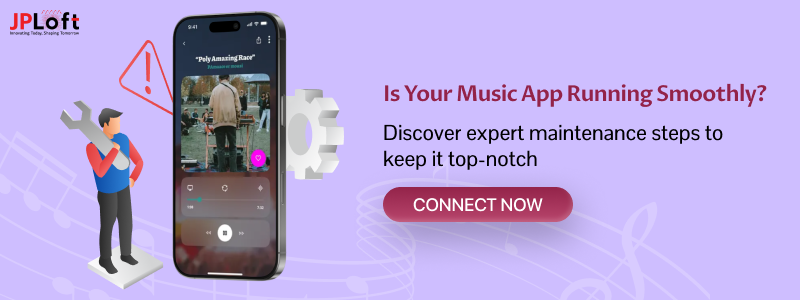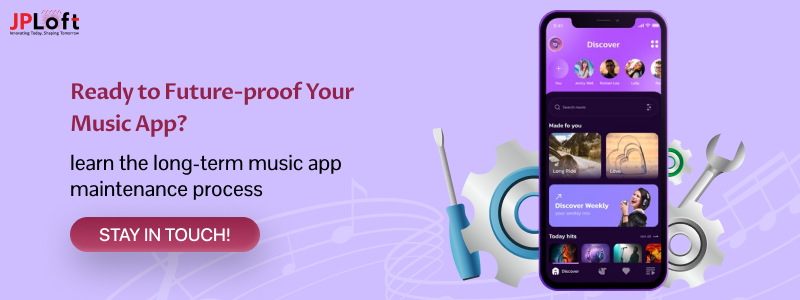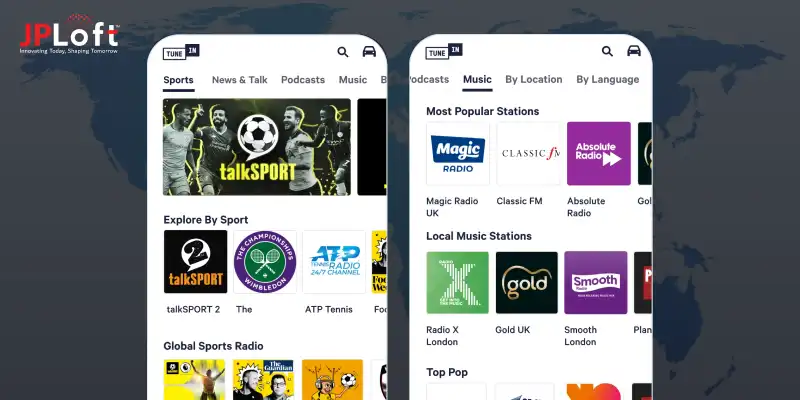Music App Maintenance is not just a one-time task, it’s an ongoing process that keeps your app running smoothly and your users happy. Whether you’ve just launched your app or it’s been live for a while, understanding the process of music app maintenance is key to long-term success.
Regular updates, bug fixes, performance checks, and user feedback all play a crucial role in making sure your music app stays relevant in a competitive market. Here comes the most important question “how to maintain a music app.”
This guide will walk you through the essential steps, from routine upkeep to all types of fixes, we’ll cover it all, no tech jargon, just clear, helpful advice.
Why Regular Music App Maintenance Matters?
Just like your phone or laptop needs updates, your app does too. Regular music app maintenance isn’t optional, it’s what keeps your app fast, safe, and user-friendly. This is one of the significant reasons why music apps fail.
So, here’s why a regular app maintenance is so important:
-
Better Performance: Routine checks help fix bugs and boost speed so users enjoy a smooth listening experience.
-
User Retention: A well-maintained app means fewer crashes and more satisfied users who’ll stick around.
-
Security & Stability: Regular updates protect against bugs and threats, keeping your app safe and trustworthy.
-
Stay Competitive: App trends and tech evolve fast. Mobile app maintenance helps you keep up and stay relevant.
-
Cost-Saving in the Long Run: Investing in long-term music app maintenance prevents costly emergency fixes later.
-
Improved User Experience: Updating features, fixing issues, and optimizing UI ensures a seamless, enjoyable journey for every user.
In short, music app maintenance isn’t a one-time thing, it’s the secret to your app’s long-term success. It also builds trust with your users, showing them that you care about delivering a high-quality and reliable music experience.
Types of Music App Maintenance
Not all music app maintenance tasks are the same, some are routine, while others pop up unexpectedly. Here are the main types you should know about:
1. Preventive Maintenance
This is the regular care you give your app to stop problems before they start. It includes performance checks, speed optimization, and code cleanups to ensure smooth operation.
2. Emergency Maintenance
When something suddenly breaks, like crashes, bugs, or security threats, this type of maintenance jumps in. Emergency music app maintenance tips are all about quick fixes to keep your app running and your users happy.
3. Corrective Maintenance
Found a glitch or user-reported issue? Corrective maintenance involves fixing bugs or broken features after they’ve been identified.
4. Adaptive Maintenance
As technology evolves, your app needs to keep up. This maintenance type includes updating APIs, adjusting to new operating systems, or integrating with the latest tools.
5. Perfective Maintenance
This is all about improving user experience by tweaking top music app features, enhancing UI, or adding updates based on user feedback.
Whether you’re planning to build music streaming app features from scratch or scale an existing one, understanding these types of music app maintenance helps you create a long-term strategy that’s smart, sustainable, and user-friendly.
What are the Main Areas of Music App Maintenance?
Music app maintenance is more than just fixing bugs when things go wrong, it's an ongoing commitment to quality, performance, and user satisfaction. If you want your app to stay competitive in the crowded music streaming space, you need to understand the key focus areas of the process of music app maintenance.
Let’s break down the main areas that every developer or app owner should include in their music app maintenance steps:
A] Performance Optimization
Nobody likes a music app that lags or crashes mid-song. One of the most critical parts of regular app maintenance is ensuring your app runs fast and smoothly.
This includes reducing app load time, improving streaming speed, and optimizing how content is loaded in the background. Regular performance tests can help identify weak points before users complain.
B] Bug Fixing & Error Resolution
Even the best apps run into issues after launch. From random crashes to broken features, bugs can sneak in during updates or when third-party services change. An effective mobile app maintenance service routine includes consistent bug tracking, testing, and timely fixes to minimize disruption. Quick error resolution builds trust with users and improves overall app ratings.
C] OS & Device Compatibility
Operating systems evolve constantly. Whether it's iOS or Android, new versions may impact how your app functions. To ensure your app stays compatible across all platforms and devices, this step must be part of your regular app maintenance process. It includes testing new OS releases, updating SDKs, and fixing UI glitches that appear on new devices.
D] UI/UX Improvements
User interface and experience play a massive role in user retention. Over time, user expectations grow, and trends shift.
As part of your long-term music app maintenance, it's important to analyze user behavior and feedback, then enhance visual design, navigation flow, and feature accessibility. A small UI tweak can lead to a big jump in engagement.
E] Security Enhancements
Security should never be an afterthought. With sensitive user data and payment details involved, your app must be protected against hacking, fraud, or data breaches.
Regular security audits, patch updates, and encryption upgrades are vital steps in the maintenance lifecycle to ensure compliance and build user trust. One emerging trend worth noting is the impact of blockchain in music apps, especially in securing user data, managing royalty distribution, and ensuring transparent digital transactions.
F] Database & Server Maintenance
Behind every music app is a powerful database that stores user data, playlists, music files, and logs. Over time, databases can become cluttered or slow.
Optimizing queries, cleaning up unused data, and ensuring server uptime are all essential for delivering a seamless user experience. This is a core part of the process of music app maintenance that many overlook.
G] Third-Party Integration Management
Music apps rely heavily on third-party services, payment gateways, social logins, analytics, and music APIs. These tools often update or change without notice.
Regularly checking and updating these integrations should be part of your music app maintenance steps to avoid service disruptions.
H] Feature Upgrades & User Feedback Implementation
One of the best music streaming apps is to never stop improving. Use app analytics, reviews, and direct feedback to add meaningful updates.
Whether it's smarter recommendations or better download features, constantly evolving your app ensures users keep coming back.
In short, successful long-term music app maintenance is about combining technical stability with user-centric improvements. Following a structured, regular app maintenance plan helps you avoid surprises, retain your audience, and keep your app performing like a chart-topping hit.
Step-By-Step Guide to Maintain a Music App
Once your music app is live, the journey doesn't end, in fact, it's just the beginning. The real challenge lies in maintaining its performance, keeping users engaged, and evolving with the latest trends in music streaming apps.
Without a robust plan in place, even the most promising app can quickly fade into digital obscurity. That’s why understanding the step-by-step process of music app maintenance is critical for ensuring long-term success, user satisfaction, and platform stability.
Step 1: Monitor & Analyze App Performance Post-Launch
After launching your music app, your top priority should be post-launch music app care. This includes real-time monitoring of app performance, user behavior, crash reports, and loading speeds.
Regular tracking helps identify bugs, glitches, or bottlenecks that can degrade the user experience. Using analytics tools like Firebase, Mixpanel, or AppDynamics, you can keep an eye on KPIs such as session length, user retention, crash-free sessions, and uninstalls.
This is the first step in building a sustainable mobile app maintenance strategy.
Step 2: Keep Your App Updated with Regular Bug Fixes
No app is perfect at launch. Minor bugs and inconsistencies are inevitable, and if left unresolved, they can frustrate users and harm your app’s credibility. A regular app maintenance involves identifying bugs quickly and rolling out updates without delay.
Make sure your development team schedules bug fixes periodically and not just in emergency situations.
Bug fixing also allows you to improve compatibility across different devices, operating systems, and screen resolutions, all of which contribute to a smoother music experience.
Step 3: Focus on UI/UX Maintenance to Improve User Retention
Great design is a moving target, especially in the world of music apps where user expectations evolve quickly. That’s why UI/UX maintenance for mobile music apps is a core part of any successful maintenance cycle.
This process includes refining visual elements, reorganizing user flows, simplifying navigation, and implementing design changes based on real user feedback. One helpful practice at this stage is app wireframing, which allows you to map out interface changes before development begins.
For example, if analytics show that users frequently drop off at the playlist creation screen, it could be a signal to redesign that part of the experience. You can test and validate such changes early through app prototyping, helping you fine-tune the design before pushing it live.
Step 4: Ensure Backend Stability & Database Optimization
A music app relies heavily on backend systems to handle streaming, downloading, user authentication, and search queries. This means regular server checks, database cleanups, API performance optimization, and load balancing are essential.
Neglecting backend issues can lead to slow app performance, which directly impacts your user base. Make it a habit to review server logs, update libraries, and optimize code for speed.
Doing so will strengthen the overall music app support and maintenance framework.
Step 5: Add New Features Based on User Behavior & Market Trends
App maintenance is not just about fixing what's broken; it's also about staying relevant. Regularly introducing new features or upgrading existing ones based on user feedback keeps your app fresh and exciting.
Refer to the app features trending in the market, like smart playlists, dark mode, or podcast integration and analyze how these can improve your app’s value.
Also, keep an eye on evolving technologies like AR/VR in music apps that are beginning to redefine how users consume music and experience live performances virtually. Integrating such innovations can help you stay ahead in a competitive market.
Step 6: Maintain Compatibility with Latest OS & Device Updates
Apple and Android frequently release updates that can affect your app’s performance or UI. Regular testing and patching ensure your music app runs smoothly on all the latest devices.
Ignoring this step can cause crashes, audio playback issues, or screen misalignment, which can lead to negative reviews and user churn. Regular app maintenance should always include OS testing, updating SDKs, and running beta tests with each new release.
If you’re unsure how to keep up, partnering with the best mobile app development company can help you manage updates efficiently and ensure long-term stability across all platforms.
Step 7: Secure Your App & User Data Continuously
As your user base grows, so does your responsibility to protect their personal data, music preferences, and payment information. A strong security infrastructure is a vital part of the best practices for music app maintenance.
This includes implementing encryption protocols, running frequent vulnerability scans, and ensuring compliance with global data privacy regulations.
As cyber threats evolve, your security measures must evolve too.
Step 8: Leverage Automation & AI for Smart Maintenance
Modern music apps are no longer maintained manually alone. The role of AI in music app maintenance is growing rapidly, helping developers detect bugs, personalize content, and optimize app performance in real time.
With predictive maintenance models, you can prevent issues before they occur, which significantly reduces downtime and improves user satisfaction.
Whether it’s through AI-driven recommendations or automated user segmentation, integrating AI ensures your music app maintenance tips are aligned with future-ready practices.
Step 9: Plan Regular Content Updates and Licensing Renewals
A music app thrives on fresh content. Make sure your content library is regularly updated with new songs, albums, and artist information. Also, keep an eye on licensing agreements to avoid service disruptions.
Scheduling these updates as part of your regular app maintenance calendar helps users stay engaged and gives them a reason to open the app frequently.
Step 10: Budget for Ongoing Support
One common mistake app owners make is spending all their budget on development and not planning for future upkeep. Be realistic about the music app development cost, and allocate a portion of it for post-launch support.
Whether it’s for server costs, developer fees, or marketing, planning ahead ensures your app remains sustainable.
Understanding how to maintain an app after launch isn't just about technical fixes, it's about having the resources and vision to evolve continuously.
The process of music app maintenance is dynamic, demanding, and crucial, and when done right. But it guarantees not just performance stability, but also long-term growth and user loyalty.
Music App Maintenance Cost Explained: Save More, Stress Less
Maintaining a music app isn’t just a technical task, it’s a smart investment in long-term success. Whether your app is newly launched or already scaling, understanding the mobile app maintenance cost helps you plan your budget better and avoid unexpected expenses.
On average, the cost of music app maintenance ranges approx. between $20,000 to $45,000, depending on factors like app complexity, third-party integrations, user base size, and frequency of updates.
This cost covers key areas such as mobile app maintenance, bug fixing, performance optimization, UI/UX upgrades, and server management.
Let’s discuss the music app maintenance cost breakdown in detail.
|
Maintenance Area |
Estimated Annual Cost |
Description |
|
Bug Fixes & Performance Updates |
$5,000 – $8,000 |
Covers routine error resolution, speed enhancements, and crash handling. |
|
UI/UX Improvements |
$3,000 – $6,000 |
Visual upgrades, user flow improvements, and design tweaks. |
|
Server & Database Maintenance |
$4,000 – $7,000 |
Ensures smooth backend operations, data handling, and storage performance. |
|
Security & Compliance Updates |
$3,000 – $5,000 |
Includes audits, encryption, GDPR or app store compliance. |
|
Third-Party API & Integration Support |
$2,000 – $5,000 |
Maintains tools like payment gateways, social logins, and music APIs. |
|
Monitoring, Analytics & Reporting |
$2,000 – $4,000 |
Tracks app health, performance metrics, and user behavior. |
Long-term planning is crucial. By committing to long-term music app maintenance, you're not only keeping your app secure and functional but also supporting your monetization strategy.
For example, if your goal is to monetize a music streaming app, maintaining top-tier performance and user experience becomes even more important.
To manage costs effectively, follow proven music app maintenance steps, perform regular audits, and prioritize feedback-driven updates. This approach not only saves money in the long run but also ensures your users keep coming back stress-free and satisfied.
Music App Maintenance Case Studies & Success Stories
When it comes to building a scalable and reliable app, consistent music app maintenance plays a game-changing role.
Let’s take a look at five successful music apps that have leveraged maintenance practices to grow their user base, improve performance, and stay ahead in the competitive streaming market.
Case Study 1: Pandora
Pandora is a classic example of a company embracing the long-term music app maintenance mindset. Through years of backend updates, UI refinements, and real-time data analysis, Pandora has continued to deliver smooth performance across devices.
Their focus on music app maintenance steps such as bug fixing and server optimization has allowed them to retain millions of loyal listeners.
Case Study 2. Spotify
Although a global brand, Spotify invests heavily in regular app maintenance for its U.S. audience. Frequent updates, user experience testing, and seamless third-party integrations have helped the app maintain low crash rates and top-tier personalization features.
Even in this competitive landscape, if you're aiming to build one of the best Spotify alternatives, prioritize music app maintenance from the start to ensure your app performs smoothly, delivers personalized experiences, and earns long-term user loyalty.
Case Study 3. iHeartRadio
As one of America’s largest digital radio platforms, iHeartRadio frequently performs critical updates as part of its process of music app maintenance. It focuses on improving live streaming quality, updating station libraries, and protecting user data.
Their ongoing maintenance strategy is the reason why iHeartRadio successfully handles high traffic without compromising performance.
Case Study 4. Audiomack
Audiomack has gained popularity by focusing on independent artists and providing fast, offline streaming. Its developers use continuous mobile app maintenance to track real-time analytics, fix minor bugs quickly, and fine-tune content delivery.
By applying strategic maintenance efforts, Audiomack grew from a niche app to a mainstream player in the U.S. music market.
Case Study 5. TIDAL
Known for its high-fidelity sound and artist-first approach, TIDAL relies on a robust music app maintenance framework. They consistently roll out music app maintenance tips in the form of security patches, performance tuning, and UX enhancements.
If you're inspired by its success and wondering about the cost to build an app like TIDAL, remember that strong maintenance is just as important as development.
These apps prove that growth isn't only about flashy features, it’s also about building strong infrastructure. Whether you're working on core fixes or implementing innovative music app ideas, having a clear music app maintenance plan ensures better retention, performance, and long-term success.
Challenges While Maintaining Your Music App
Handling music app maintenance may sound like a routine job, but in reality, it comes with several tricky roadblocks. Here are some of the major challenges you might face:
-
OS & Device Compatibility Issues: Frequent updates in Android and iOS often lead to sudden performance glitches, making it tough to keep your app stable across all devices.
-
Hidden Bugs & Performance Lags: Some bugs aren’t visible during testing but show up later, affecting app speed and user experience.
-
Security Vulnerabilities: One of the top challenges of music apps is protecting sensitive user data from breaches or cyber threats.
-
Third-Party Service Breakdowns: APIs, payment systems, or music streaming servers might suddenly fail or update, requiring immediate attention.
-
Balancing New Features with Maintenance: When teams focus on scaling or adding features, routine maintenance tasks often get delayed, impacting long-term app health.
-
Quick Solution: To overcome these challenges of music apps, app owners should implement a structured music app maintenance plan. Regular testing, security audits, and third-party integration monitoring are key.
Investing in expert mobile app maintenance services can also reduce downtime and ensure your app continues to deliver a high-quality user experience, whether you're maintaining or planning to build music app features.
Why is JPLoft the Right Choice for Music App Maintenance?
If you're looking for a reliable partner to manage your music app post-launch, JPLoft has you covered. As a top-rated music streaming app development company, we not only build powerful music apps but also ensure they run smoothly with long-term maintenance and support.
From fixing bugs and improving performance to keeping up with OS updates and third-party integrations, our team handles every detail with care. We understand that music apps require continuous updates to meet evolving user expectations, and that’s exactly what we deliver.
With years of experience in music app maintenance, we help you reduce downtime, enhance user experience, and stay ahead in the competitive music streaming industry.
So whether you’re planning to launch or scale, trust us to keep your app at its best, always.
Final Wrap-Up
Music app maintenance isn’t just a technical chore, it’s a key factor in keeping your users engaged and your platform competitive. From handling bug fixes and OS updates to improving app performance and user satisfaction, regular upkeep ensures your music app performs at its best.
Whether you're facing minor glitches or preparing for a major update, having a reliable maintenance plan can make all the difference. By investing in consistent and expert support, you're not just maintaining your app, you’re future-proofing it.
If you truly want your music app to stay relevant, secure, and high-performing in a fast-changing digital space, prioritizing app maintenance is non-negotiable.
FAQs
Regular maintenance keeps your app secure, bug-free, and compatible with the latest OS updates, ensuring a smooth user experience.
Ideally, you should perform checks monthly and release updates every 2–3 months or as needed based on feedback and OS changes.
Services typically include bug fixes, performance optimization, API updates, UI/UX improvements, and security patches.
Common challenges include bug tracking, OS compatibility, third-party integration issues, and maintaining security.
The cost varies depending on the app's complexity, update frequency, and whether you're handling it in-house or outsourcing it.













Share this blog